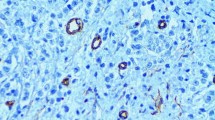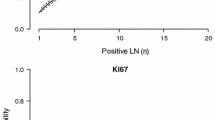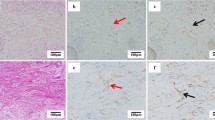Abstract
We compared microvascular density (MVD), lymph vessel density (LVD), and the expression of hypoxia pathway-associated proteins between primary triple-negative adenoid cystic carcinoma of the breast (TN-ACC) and grade-matched triple-negative breast carcinomas of no special type (TNBC). Twelve TN-ACC and 15 TNBC were investigated immunohistochemically for CD31, podoplanin (D2-40), von Hippel–Lindau protein (pVHL), and hypoxia-inducible factor-1alpha (HIF-1α) protein. All cases were lymph node negative (pN0). The study revealed a median MVD (CD31) of 34 vessels/mm2 (mean ± SD, 41.33 ± 6.5/mm2) in the TN-ACC subgroup and a median of 55 microvessels (mean ± SD, 54.9 ± 6.3/mm2) in the TNBC subgroup. The median LVD (D2-40) was 10.5/mm2 (mean ± SD, 11.9 ± 1.5/mm2) in the TN-ACC subgroup and 15.0/mm2 (mean ± SD, 16.9 ± 2.5/mm2) lymph vessels in the TNBC subgroup. The differences were not statistically significant (P = 0.93, P = 0.67, respectively). pVHL was detectable in all TN-ACCs whereas two cases of TNBC had less than 5% of the positive cells. HIF-1α protein expression was significantly higher in the tumor cell population than in adjacent normal cells in both subgroups (P = 0.009 for TNBC and P = 0.028 for TN-ACC, respectively), but there was no significant difference between the two tumor groups. Up-regulation of the hypoxia-induced signaling is seen in both TN-ACC and grade-matched TNBC. Despite its perceived low malignant potential, TN-ACC of the breast does not differ in the number of blood and lymphatic vessels in comparison with the grade-matched TNBC. The reported biologic differences between TN-ACC and TNBC do not appear to result from neoangiogenesis.


Similar content being viewed by others
References
Hanahan D, Weinberg RA (2011) Hallmarks of cancer: the next generation. Cell 144:646–674
Hanahan D, Weinberg RA (2000) The hallmarks of cancer. Cell 100:57–70
Folkman J (2007) Is angiogenesis an organizing principle in biology and medicine? J Pediatr Surg 42:1–11
Weinberg RA (2007) The biology of cancer. Garland Science, Taylor & Francis Group, LLC, New York
Weidner N (2004) The importance of tumor angiogenesis. Am J Clin Pathol 122:675–677
Lundgren K, Holm C, Landberg G (2007) Hypoxia and breast cancer: prognostic and therapeutic implications. Cell Mol Life Sci 64:3233–3247
Haase VH (2006) The VHL/HIF oxygen-sensing pathway and its relevance to kidney disease. Kidney Int 69:1302–1307
Calzada MJ (2010) Von Hippel-Lindau syndrome: molecular mechanisms of the disease. Clin Transl Oncol 12:160–165
Lantzsch T, Hefler L, Koelbl H, Lampe D (2002) Expression of von Hippel-Lindau gene protein in breast cancer tissue. Gynecol Oncol 84:186–187
Sourvinos G, Miyakis S, Liloglou TL, Field JK, Spandidos DA (2001) Von Hippel-Lindau tumour suppressor gene is not involved in sporadic human breast cancer. Tumour Biol 22:131–136
Corless CL, Kibel AS, Iliopoulos O, Kaelin WG Jr (1997) Immunostaining of the von Hippel-Lindau gene product in normal and neoplastic human tissues. Hum Pathol 28:459–464
Mohammed RA, Ellis IO, Mahmmod AM et al (2011) Lymphatic and blood vessels in basal and triple-negative breast cancers: characteristics and prognostic significance. Mod Pathol 24:774–785
Sabatier R, Jacquemier J, Bertucci F et al (2011) Peritumoural vascular invasion: a major determinant of triple-negative breast cancer outcome. Eur J Cancer Mar 8 doi:10.1016/j.ejca.2011.02.002
Khanfir K, Kallel A, Villette S et al (2011) Management of adenoid cystic carcinoma of the breast: a rare cancer network study. Int J Radiat Oncol Biol Phys (in press) May 11. doi:10.1016/j.ijrobp.2010.12.008
Ghabach B, Anderson WF, Curtis RE, Huycke MM, Lavigne JA, Dores GM (2010) Adenoid cystic carcinoma of the breast in the United States (1977 to 2006): a population-based cohort study. Breast Cancer Res 12:R54
Vranic S, Frkovic-Grazio S, Lamovec J et al (2010) Adenoid cystic carcinomas of the breast have low Topo IIα expression but frequently overexpress EGFR protein without EGFR gene amplification. Hum Pathol 41:1617–1623
Edge SB, Byrd DR (2010) AJCC cancer staging manual, 7th edn. Springer, Berlin
Zhang XT, Kang LG, Ding L, Vranic S, Gatalica Z, Wang ZY (2011) A positive feedback loop of ER-α36/EGFR promotes malignant growth of ER-negative breast cancer cells. Oncogene 30:770–780
Vranic S, Gurjeva O, Frkovic-Grazio S, Palazzo J, Tawfik O, Gatalica Z (2011) IMP3, a proposed novel basal phenotype marker, is commonly overexpressed in adenoid cystic carcinomas but not in apocrine carcinomas of the breast. Appl Immunohistochem Mol Morphol Mar 22 (in press) doi:10.1097/PAI.0b013e3182143399
Weidner N, Semple JP, Welgh WR, Folkman J (1991) Tumor angiogenesis and metastasis – correlation in invasive breast carcinoma. N Engl J Med 324:1–8
Yan M, Rayoo M, Takano EA, KConFab Investigators, Fox SB (2009) BRCA1 tumours correlate with a HIF-1alpha phenotype and have a poor prognosis through modulation of hydroxylase enzyme profile expression. Br J Cancer 101:1168–1174
Vranic S, Bilalovic N, Lee LM, Kruslin B, Lilleberg SL, Gatalica Z (2007) PIK3CA and PTEN mutations in adenoid cystic carcinoma of the breast metastatic to kidney. Hum Pathol 38:1425–1431
Weigelt B, Geyer FC, Reis-Filho JS (2010) Histological types of breast cancer: How special are they? Mol Oncol 4:192–208
Weigelt B, Horlings HM, Kreike B et al (2008) Refinement of breast cancer classification by molecular characterization of histological special types. J Pathol 216:141–150
Otrock ZK, Hatoum HA, Awada AH et al (2009) Hypoxia-inducible factor in cancer angiogenesis: structure, regulation and clinical perspectives. Crit Rev Oncol Hemat 70:93–102
Voss MJ, Moller MF, Powe DG, Niggemann B, Zanker KS, Entschladen F (2011) Luminal and basal-like breast cancer cell show increased migration induced by hypoxia, mediated by an autocrine mechanism. BMC Cancer 11:158
Bos R, Zhong H, Hanrahan CF et al (2001) Levels of hypoxia-inducible factor-1 alpha during breast carcinogenesis. J Natl Cancer Inst 93:309–314
Kimbro KS, Simons JW (2006) Hypoxia-inducible factor-1 in human breast and prostate cancer. Endocr Relat Cancer 13:739–749
Carroll V, Ashcroft M (2006) Role of hypoxia-inducible factor (HIF)-1A versus HIF-2A in the regulation of HIF target genes in response to hypoxia, insulin-like growth factor-I, or loss of von Hippel-Lindau function: implications for targeting the HIF pathway. Cancer Res 66:6264–6270
Bos R, van Diest PJ, de Jong JS, van der Groep P, van der Valk P, van der Wall E (2005) Hypoxia-inducible factor-1alpha is associated with angiogenesis, and expression of bFGF, PDGF-BB, and EGFR in invasive breast cancer. Histopathology 46:31–36
Bos R, van der GP, Greijer AE et al (2003) Levels of hypoxia-inducible factor-1alpha independently predict prognosis in patients with lymph node negative breast carcinoma. Cancer 97:1573–1581
Ryu K, Park C, Lee Y (2011) Hypoxia-inducible factor 1 alpha represses the transcription of the estrogen receptor alpha gene in human breast cancer cells. Biochem Biophys Res Commun 407:831–836
Rakha EA, Elsheikh SE, Aleskandarany MA et al (2009) Triple-negative breast cancer: distinguishing between basal and nonbasal subtypes. Clin Cancer Res 15:2302–2310
Vleugel MM, Bos R, Buerger H et al (2004) No amplifications of hypoxia-inducible factor-1alpha gene in invasive breast cancer: a tissue microarray study. Cell Oncol 26:347–351
Trastour C, Benizri E, Ettore F et al (2007) HIF-1alpha and CA IX staining in invasive breast carcinomas: prognosis and treatment outcome. Int J Cancer 120:1451–1458
van der Groep P, Bouter A, Menko FH, van der Wall E, van Diest PJ (2008) High frequency of HIF-1alpha overexpression in BRCA1 related breast cancer. Breast Cancer Res Treat 111:475–480
Kaelin WG Jr (2002) Molecular basis of the VHL hereditary cancer syndrome. Nat Rev Cancer 2:673–682
Lin F, Shi J, Liu H et al (2008) Immunohistochemical detection of the von Hippel-Lindau gene product (pVHL) in human tissues and tumors: a useful marker for metastatic renal cell carcinoma and clear cell carcinoma of the ovary and uterus. Am J Clin Pathol 129:592–605
Lopez-Garcia MA, Wetterskog D, Lambros MB et al (2011) Genomic profiling of adenoid cystic carcinomas of the breast. Mod Pathol 24(suppl1):52A (meeting abstract 205)
Acknowledgments
We are grateful to Ms. Mindee C. Kurtis, Creighton Medical Laboratories, Creighton University Medical Center (Omaha, NE) for excellent technical assistance.
Conflict of interest
We declare that we have no conflict of interest.
Author information
Authors and Affiliations
Corresponding author
Rights and permissions
About this article
Cite this article
Vranic, S., Frkovic-Grazio, S., Bilalovic, N. et al. Angiogenesis in triple-negative adenoid cystic carcinomas of the breast. Virchows Arch 459, 377–382 (2011). https://doi.org/10.1007/s00428-011-1144-4
Received:
Revised:
Accepted:
Published:
Issue Date:
DOI: https://doi.org/10.1007/s00428-011-1144-4




